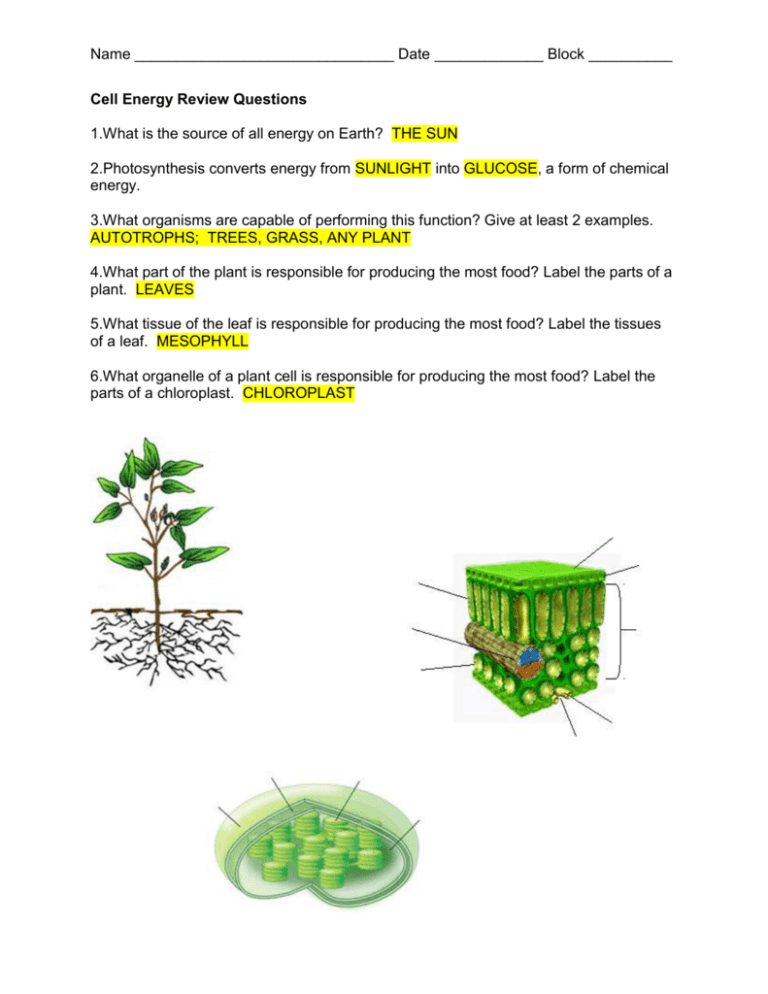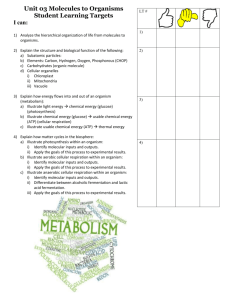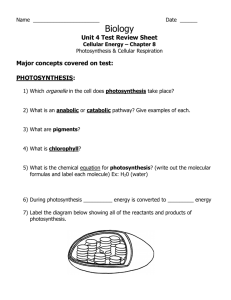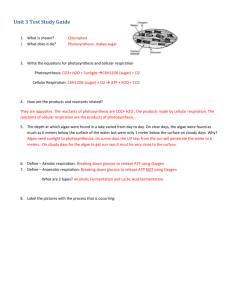Review Worksheet Answer Key
advertisement

Name _______________________________ Date _____________ Block __________ Cell Energy Review Questions 1.What is the source of all energy on Earth? THE SUN 2.Photosynthesis converts energy from SUNLIGHT into GLUCOSE, a form of chemical energy. 3.What organisms are capable of performing this function? Give at least 2 examples. AUTOTROPHS; TREES, GRASS, ANY PLANT 4.What part of the plant is responsible for producing the most food? Label the parts of a plant. LEAVES 5.What tissue of the leaf is responsible for producing the most food? Label the tissues of a leaf. MESOPHYLL 6.What organelle of a plant cell is responsible for producing the most food? Label the parts of a chloroplast. CHLOROPLAST Name _______________________________ Date _____________ Block __________ 7.Where in the chloroplast do the Light reactions occur? THYLAKOID 8.Where in the chloroplast does the Calvin cycle occur? STROMA 9.Write the equation for photosynthesis below. Underneath the chemicals, identify which part of photosynthesis each chemical is a reactant or product of (LR or CC). 6CO2 CC + 6H2O C6H12O6 + 6CO2 LR LR CC 10.Which chemicals transfer energy from the Light Reactions to the Calvin Cycle? NADPH & ATP 11.What does NADPH become when is releases electrons? NADP+ 12.What does ATP become when energy is released? ADP 13.Where in a chloroplast will you find the most chlorophyll? THYLAKOID 14.Explain why plants with a lot of chlorophyll do not grow well under green light. CHLOROPHYLL IS GREEN BECAUSE IT REFLECTS GREEN LIGHT. IF ONLY GREEN LIGHT IS PROVIDED, CHLOROPHYLL WILL NOT BE ABLE TO ABSORB ANY LIGHT ENERGY FOR PHOTOSYNTHESIS 15.In a hypothetical experiment, a scientist enclosed two plants into two plastic bags. Both were ivy plants, had the same starting mass, were given the same amount of water and had the same amount of soil and sunlight. However, the scientist would talk to one of the plants through a small opening three times a day. He would always reseal the bag. After two weeks, he found the masses of each plant and found that the plant he talked to had more mass than the plant he did not talk to. Explain the results. BY TALKING TO THE PLANT, THE SCIENTIST WAS PROVIDING MORE CARBON DIOXIDE. WITH MORE CARBON DIOXIDE, THE PLANT IS ABLE TO DO MORE PHOTOSYNTHESIS (SPECIFICALLY, THE CALVIN CYCLE) AND MAKE MORE FOOD. MORE FOOD PROVIDES MORE ENERGY TO GROW. Name _______________________________ Date _____________ Block __________ 1.Cellular Respiration converts energy from GLUCOSE into ATP, a form of chemical energy. 2.This process is AEROBIC and can only occur in the presence of OXYGEN. 3.What organisms are capable of performing this function? Give at least 5 examples. AUTOTROPHS & HETEROTROPHS (ALL ORGANISMS): PLANTS, ANIMALS, FUNGI, PROTISTS 4.What organelle (part of the cell) is responsible for carrying out Cellular Respiration? MITOCHONDRION 5.Label the parts of a mitochondrion. 6.What are the 3 main reactions that occur in Cellular Respiration? GLYCOLYSIS, KREBS CYCLE, ELECTRON TRANSPORT CHAIN 7.Where in the cell does Glycolysis occur? CYTOPLASM 8.Where in the mitochondrion does the Krebs Cycle occur? MATRIX 9.Where in the mitochondrion does the Electron Transport Chain occur? INNER MEMBRANE 10.Explain why it is beneficial for a mitochondrion to have more cristae? MORE CRISTAE MEANS MORE FOLDS IN THE INNER MEMBRANE. WITH MORE FOLDS, MORE SURFACE AREA IS AVAILABLE FOR MORE REACTIONS FROM THE ELECTRON TRANSPORT CHAIN. THIS ALLOWS THE MITOCHONDRION TO MAKE EVEN MORE ATP. Name _______________________________ Date _____________ Block __________ 11.Write the equation for Cellular Respiration below. Underneath the chemicals, identify which part of Cellular Respiration each chemical is a reactant or product of (G, KC or ETC). C6H12O6 + 6O2 6CO2 + 6H20 G ETC KC ETC 12.Which chemicals transfer energy from the Kreb Cycle to the Electron Transport Chain? NADH & FADH2 13.What does NADH become when it releases electrons? NAD+ 14.What does FADH2 become when it releases electrons? FAD 15.What enzyme is responsible for making ATP? ATP SYNTHASE 16.What does oxygen do that is so important? OXYGEN ACCEPTS THE ELECTRONS AS THEY FINISH PASSING THROUGH THE ELECTRON TRANSPORT CHAIN. TOGETHER, THEY BECOME WATER. 17.Which part of cellular respiration releases CO2? KREBS CYCLE 18.How much ATP can be produced from 1 molecule of glucose? 38 ATP 19.Explain why there is only a net production of 2 ATP from glycolysis. 2 ATP ARE USED TO START THE PROCESS (INVESTMENT) AND 4 ATP ARE PRODUCED AT THE END OF GLYCOLYSIS. 4 ATP – 2 ATP = 2 ATP NET 20.A small water plant is placed in a solution of Bromothymol blue. BB turns a yellow color when it absorbs CO2 from the air (it makes the solution acidic). Explain why when the plant is in the sunlight, the solution remains blue, but when placed in darkness for several hours, the solution turns yellow. IN THE SUNLIGHT, THE PLANT IS ABLE TO CONDUCT PHOTOSYNTHESIS, SO IT USES THE CO2 AND THE SOLUTION REMAINS BLUE. IN THE DARK, THE PLANT CAN ONLY DO CELLULAR RESPIRATION AND NOT PHOTOSYNTHESIS. IT PRODUCES CO2 AND THE SOLUTION TURNS YELLOW. 1.When oxygen is NOT present, FERMENTATION converts glucose (chemical energy) into ATP. 2.This process occurs in the CYTOPLASM of the cell. And only produces 2 ATP. 3.It is called ANAEROBIC since it can occur without oxygen. 4.Alcoholic Fermentation can occur in YEAST and BACTERIAL cells. It produces CO2 and ETHANOL. Name _______________________________ Date _____________ Block __________ 5.Lactic Acid Fermentation can occur in MUSCLE and BACTERIAL cells. It produces LACTIC ACID. 6.Name food products from each type of Fermentation. YOGURT, CHEESE, PICKLES, KIMCHI, ALCOHOLIC BEVERAGES, SAUERKRAUT… Critical Thinking Questions: 1. Compare and contrast Alcoholic Fermentation with Cellular Respiration. 2. Describe the relationship between Photosynthesis and Cellular Respiration. 3. Explain the importance of recycling NAD+ in Fermentation 4. Explain how breathing is related to Cellular Respiration. 5. Explain the benefits of Aerobic Respiration over Anaerobic Respiration. Explain the benefits of Anaerobic Respiration over Aerobic Respiration.








